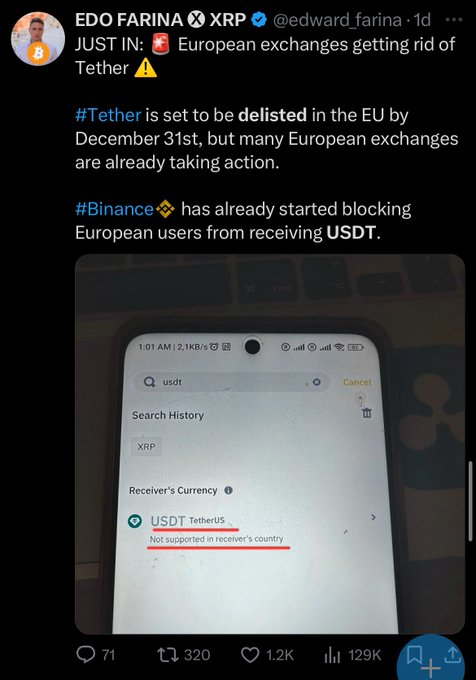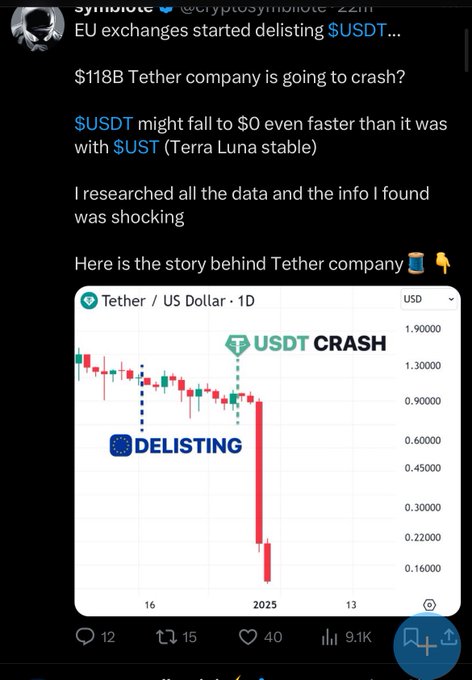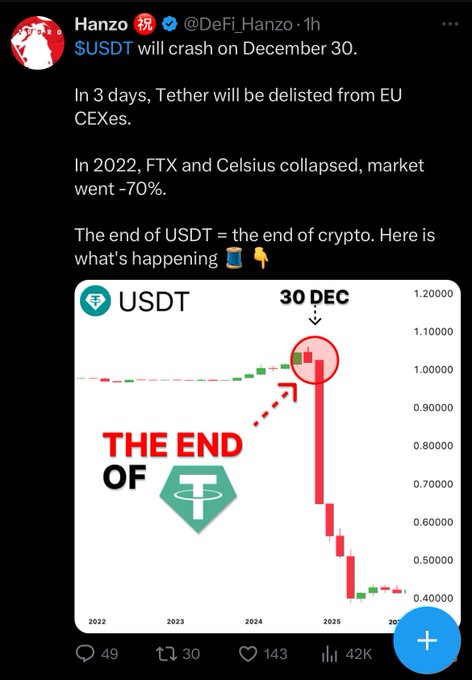- Published on
Is USDT at risk of being de-listed on CEX exchanges in the EU?
- Authors

- Name
- Administrator
- @airdropdecks
With the new European Union regulation on cryptocurrencies coming into force, doubts about USDT's compliance and future are sweeping the market. Is this the end of Tether in Europe?
Tether, the company behind the USDT stablecoin — a cryptocurrency designed to anchor value to the dollar, is facing new challenges as the European Union's Markets in Crypto-Assets Regulation (MiCA) comes into force on December 30.
The introduction of MiCA, which includes new regulations, with strict transparency and reserve requirements, has created a wave of fear, and doubt about USDT's compliance.
On forums and social networks, especially X (Twitter), many people question whether Tether meets the standards of MiCA, and what effect this has on the stability of USDT, which is the stablecoin with the largest trading volume in the world.
Although Tether insists that it is working to meet MiCA's requirements, the company has not yet received a license to trade on CEX exchanges. This caused many to fear that USDT could be de-listed on many European exchanges, making it difficult for investors in the region.
USDT plays an important role in the cryptocurrency market, is widely used in transactions and is a bridge between cryptocurrencies and fiat currencies. Any disruption to USDT can cause strong market volatility, including:
- Liquidity Reduction: Removing USDT from EU exchanges could significantly reduce market liquidity. This will make it difficult for traders to execute large orders without affecting the price, increasing the risk of slippage.
- Increase transaction costs:Investors may be forced to convert their assets to alternative stablecoins or fiat currencies, resulting in additional transaction fees and unfavorable exchange rates.
- Market Fragmentation:The absence of USDT can lead to a fragmented market, as traders may switch to platforms outside the EU or favor other stablecoins. This can affect the connectivity of the trading environment, creating inefficiencies and increasing risk for investors.
However, it is not the first time Tether has faced suspicion due to bad news. In fact, this company has been constantly entangled in problems related to the issuance and legalization of property since 2017.
Tether made untrue audit promises, was fined huge sums, and faced multiple allegations of a lack of transparency in its operations.

Amid the uproar, Tether CEO Paolo Ardoino has reassured the community, calling the FUD surrounding USDT a “smear campaign” by competitors. He insisted Tether was working closely with regulators and was confident about its MiCA compliance capabilities.
One of the most notable developments was the decision by Coinbase, one of the world's largest cryptocurrency exchanges, to de-list USDT to comply with MiCA.
Meanwhile, other exchanges such as Binance and Crypto.com continue to support USDT, but said they are closely monitoring the situation and waiting for specific guidance from regulators.

MiCA is a comprehensive set of rules aimed at regulating the cryptocurrency market in the EU region, with the goal of strengthening investor protection and promoting financial stability.
MiCA sets out a series of requirements for stablecoin issuers, including:
- Cryptocurrency License: Companies wishing to issue stablecoins in the EU must apply for a license from the regulatory authority.
- Reserves: Stablecoins must be fully backed by reserve assets, and at least two-thirds of reserves must be held in independent banks.
- Transparency: Issuers must publicly disclose information about their reserves and operations.
MiCA is posing major challenges to this stablecoin, and whether Tether can overcome those challenges will depend on its ability to adapt and meet the requirements of the new regulation.



